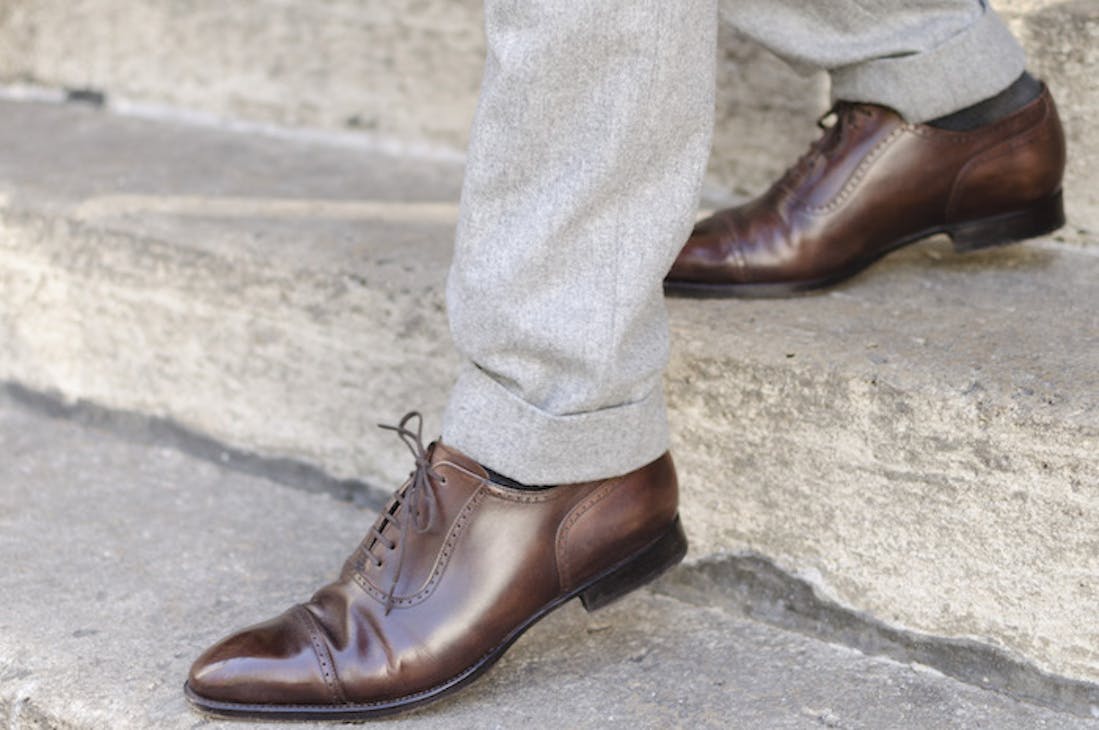A few years after this excellent article by Romain, our editor Jordan once again looked into the vast, sometimes controversial subject of the quality of leather and shoes. Here is the (almost) complete guide:
- Part 1: Why is leather expensive?
- Part 2: How to know if your shoes will last
- Part 3: the method for choosing the right size and shape
- Part 4: how to find your shoe style
- Part 5: maintain and repair your shoes to make them last
- Part 6a: which brands should you buy?
Good reading ! You are not immune to learning a lot of things. 😉
Choosing shoes is not always easy: a design can catch the eye and spark a crush, but how can you ensure that the pair of your dreams won't deteriorate after just a few wears? There are several criteria to take into account. 😉

Your outfit may be perfect, but mediocre shoes will ruin your look. Hence the importance of choosing them carefully (Paire & Fils shoes).
The price is already an indicator. A pair of shoes for €90 is not (and will never be) “normal”. Hides and other materials, labor, transport, marketing, sales, taxes: no miracles!
Manufacturers of low-cost shoes take advantage of all costs, starting of course with the salaries of those who manufacture them (without forgetting the materials, the types of assembly)... Remember that a well-made product, in addition to clearly looking better, will also last much, much longer.

Mmmmh beautiful, inexpensive shoes with atrocious leathers: who could say worse?
The place of manufacture can also give a good indication of the quality of the shoes. Despite what we constantly try to believe in order to deceive the customer, Italy, France and the United Kingdom remain the greatest shoe experts in the world, without forgetting Spain and Portugal (more recently).
For what ? Simply because it is in these countries that the know-how was created. You can definitely come across a poorly made Made in Italy pair, that's for sure, but it's clear that it's often a guarantee of quality. The workforce fully deserves to be recognized for the work it is capable of offering.

Shoe craftsmanship has been going on for centuries in Europe. Salvatore Ferragamo (here in his workshop) is one of those remarkable names in the history of luxury shoes: he began working as a bootmaker at the age of 11!
Finally, there is no irrefutable formula to say whether or not a shoe is of quality: I am simply sharing with you some advice that was passed on to me by good shoemakers.
In the first part of this article, we will focus on leather, which constitutes the basic material of quality shoes. If you want to go into detail, I wrote the leather guide some time ago, which works for clothes as well as shoes.
How to recognize quality leather for shoes?
Aside from a few exceptions or style choices, good shoes are made from leather. Can be dyed in all possible colors imaginable, it offers an unrivaled texture and can last a very, very long time.
A distinction is made between the different qualities of skins, then between the treatments (color, possible protections, etc.) that they then receive to truly become leather. A little summary reminder...

In descending order of quality:
Full flower. All layers of the skin are preserved, and especially the upper part of the dermis, the most beautiful and softest! In terms of finishes, we often find them aniline or dipped, that is to say only bathed in a bath of pigments or dyes: their texture is exceptional, but these skins remain very exposed to dirt.
Boxcalf (calf tanned with chrome salts, more appropriate than vegetable tanning for shoes) is the most widespread example, with a perfect smooth finish. This layer is also excellent for all suede leathers: sanding suedes or nubuck reveals the slightest imperfection!

The flower is passed through this large, but delicate machine, which will sand it to obtain the nubuck.
The flower corrected. The top layer of dermis is removed because it has imperfections, but it will never look as good as a full grain. Most often, it receives treatments to be pigmented, and smoothed/protected by a thin transparent film.
Split leather. We only keep the lower layers, the strongest but also the least beautiful. The “pigmented” finish mummifies the skin in a sarcophagus of opaque dyes with the aim, again, of uniforming it. This treatment often generates a fairly unearthly shine, which will be unpleasant to see and touch.
Appearance of good leather
“Smooth” leathers
Many hides are exploited for the fineness of their grain and their very smooth appearance. Veal (widely used), lamb (rarer), but also buffalo or deer with their large grains, reward us with their superb textures.
Well worked, their appearance will be from matt to shiny depending on the finishes, but the essential element of quality leather will be its regularity. Whether the grain of the skin is fine or accentuated (grained/tumbled leathers), it must be the same over the entire surface.

The grain is fine, regular, and captures the light well: an excellent sign (Souliers Paul Evans).
Boxcalf, which we have mentioned, is a refined and elegant leather: when viewed, it offers a natural shine. The light reflects diffusely on this material, sometimes revealing certain nuances of color depending on the desired effects.
Velvet leathers
As their name suggests, suedes and other nubucks have a velvety appearance thanks to the sanding they have undergone. So obviously, visually, the closer we get to a “peach skin” texture, the better the quality will be!
Avoid too coarse aspects as much as possible, even if it is rare to find on shoes the fineness of the "grain" that we find in ready-to-wear.

Beautiful Atelier Voisin nubuck ankle boots will take on character as they age.
A good “test” of the quality and regularity of suede leather: run your finger over it. If you obtain a very clear trace, you will be able to deduce that the finish is good!

The square that I drew is clearly visible, and brings out the fineness of the velvet!
Finally, this type of leather work does not forgive any imperfection: sanding reveals absolutely all the small defects of a skin. Needless to say, you will have to be careful on this point, because it can really harm the aesthetics of the shoe!
Touch of good leather
Smooth leathers
Nothing could be simpler to recognize quality smooth leather by touch: it is soft and regular . Note that for glossy leathers, the smooth sensation will be pushed to the extreme.

Perfect leather from Septième Largeur, that you want to touch.
I have already had the opportunity to share this feeling with you, but leather is truly a “sensual” material: by passing your hand over beautiful skin, it will very quickly warm up to your temperature. It's important to feel a certain "warmth" when touching leather, even if this element is ultimately quite difficult to describe.
Let's just remember that quality leather is extremely pleasant to the touch!
Velvet leathers

On the left, a rough sanding, while on the right, the skin appears much softer and finer.
Here again, downy softness and regularity of texture guarantee quality material and workmanship. On the other hand , rough or even rough textures should simply be banned: they risk being damaged much more quickly than the others, if not downright smoothing out in a terrible way!
Suede and nubuck leathers are also finishes that should highlight the “warmth” and sensuality of the leather, and provide a pleasant sensation there too.
In the second part of the article, I will offer you a zoom on the different types of shoe fittings that exist, to finally understand what distinguishes them from each other, and their advantages/disadvantages. Finally, we will finish by examining the details that can make the difference.
Not forgetting our own dress shoes...
Thanks to the Tanneries d'Annonay and our Barker Shoes workshop, we have developed real bootmaking know-how: assembly in England from A to Z.






